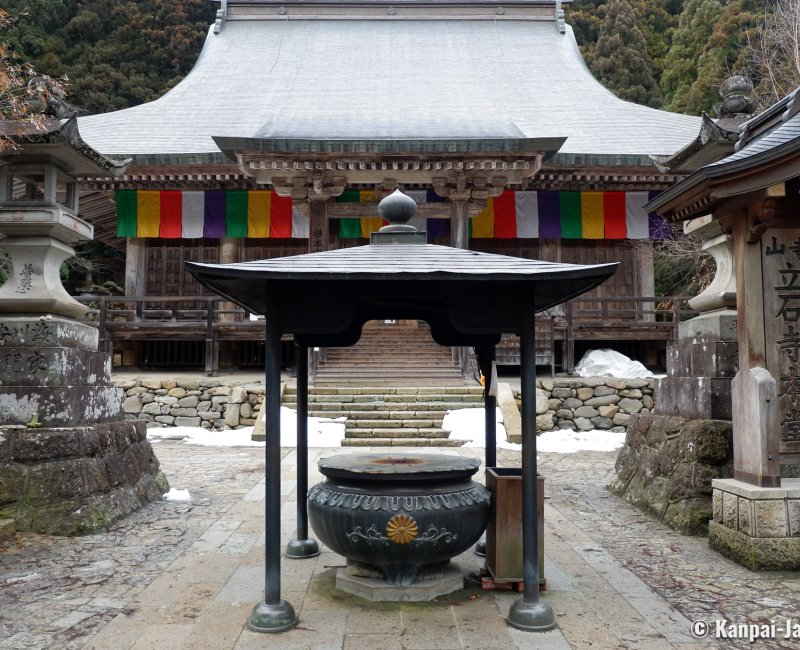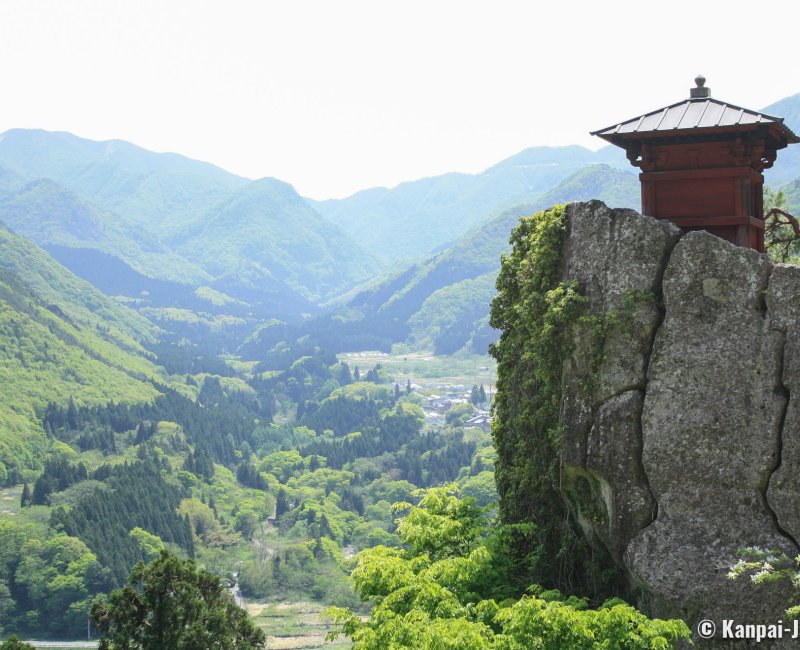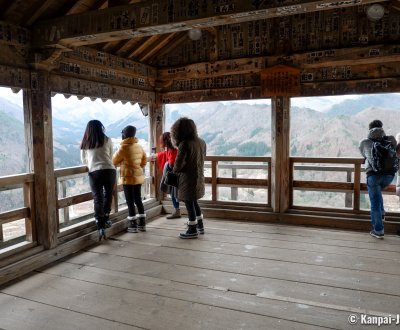Yamadera
The Mountain Temple in Yamagata
Yamadera is a Buddhist temple of the Tendai School spreading on the side of a mountain located between the cities of Yamagata and Sendai, in northern Japan’s Tohoku area. Risshaku-ji, as per its official name, is leaning on the slopes of Mount Hoshu and is highlighted by an observation platform commanding a view on the valley and various pavilions nestled in the rocks, accessible by a 1,015 steps pilgrimage trail.
Yamadera Temple, officially called Risshaku-ji, is said to have been founded in 860 at the request of Emperor Seiwa (850 - 881) by monk Jikaku Daishi (794 – 864), a leading figure of the Tendai Buddhism, also called Ennin.
A renowned Buddhist pilgrimage
Yamadera is part to several pilgrimage courses in the Tohoku, such as:
- The Shiji Kairo (四寺廻廊), a popular pilgrimage trail connecting 4 temples in relation to Ennin in the area: Zuigan-ji in Matsushima as well as Chuson-ji and Motsu-ji in Hiraizumi to Yamadera and viewable within a day;
- The Mogami 33 Kannon (最上三十三観音) pilgrimage, a more confidential course treading throughout Yamagata prefecture.
Amateurs of beautiful calligraphy can have their goshuin notebook ready to collect the marvelous ink drawings made by the monks to certify their visit at the temple and keep a great souvenir.

A thousand steps and a succession of pavilions
From the small Yamadera JR station, a few minutes’ walk through the village are enough to reach the entrance of the temple complex. Several religious buildings already stand at the foot of the appropriately named "mountain temple", in particular the main hall called Konponchu-do.
Rebuilt in the 14th century, this pavilion is nowadays the oldest beech wood construction of Japan, and therefore designated National Treasure. It shelters a statue of Yakushi Nyorai, the Buddha of medicine and healing, and a flame from Shiga prefecture’s Enryaku-ji temple, which has been permanently burning since the early days of the religious site, approx. 1,000 years ago.
The Homotsu-den pavilion houses the Treasure Hall where are preserved various Buddhist representations such as Monju Bosatsu and Bishamonten, and especially a sacred founding sutra dating to 1144 and designated Important Cultural Property.
Then, the 1,015-steps stairway unfolds on the side of the mountain, for a 30 minutes’ ascension. The first major stop on the climb is in front of Mida-Hora, a rock carved into the Buddha Amida Nyorai. After a moment of recollection, the path continues in a steep stairway passing through the Niomon gate. It was rebuilt in 1848 and as such is one of the most recent constructions of the site, marking the opening of the upper part of the temple, up to the Okunoin.
Pilgrims are focusing on keeping count of the number of steps they ascended. Meanwhile, sightseers enjoy the small esplanades laid out to accommodate various buildings, that allow to take a break. Of the constructions, 2 are particularly remarkable:
- Kaisando pavilion, dedicated to the founder of the place; and,
- Nokyodo, a small red altar, used for sutra copying, in the heights.
While they are not all accessible to visitors, a remarkable number of small wooden constructions embedded in the stone also contribute to the charm of this landscape that is both natural and mystical.

A visual and spiritual gratification
The temple’s monks climb the Yamadera every day, and the feat is both physical and spiritual. The ascension is intended to leave the evil spirits behind and reach greater heights and serenity. The needs and desires born form the contemporary world gradually fade away as one climbs the mountain and reaches its top light and relieved from their weight.
The pilgrimage ends in front of the Godaido pavilion which, beside its religious function, is also a panoramic viewing platform on the valley. The stunning view unfolding here is perfectly phrased in a haiku by famous poet Basho Matsuo (1644 - 1694) composed after he discovered Yamadera in 1689:
閑さや岩にしみ入る蝉の声
Shizukasaya / iwa ni shimiiru / semi no koe
That can be translated as:
Deep silence、
the shrill of cicadas、
seeps into rocks.
On a side note, the trill of the local locusts, called 山寺の蝉 Yamadera no semi, is listed among the 100 soundscapes of Japan (日本の音風景100選).
Back at the foot of the mountain, the mind at peace, amateurs of Japanese literature can visit the Yamadera Basho Memorial Museum, located in the station’s vicinity.

